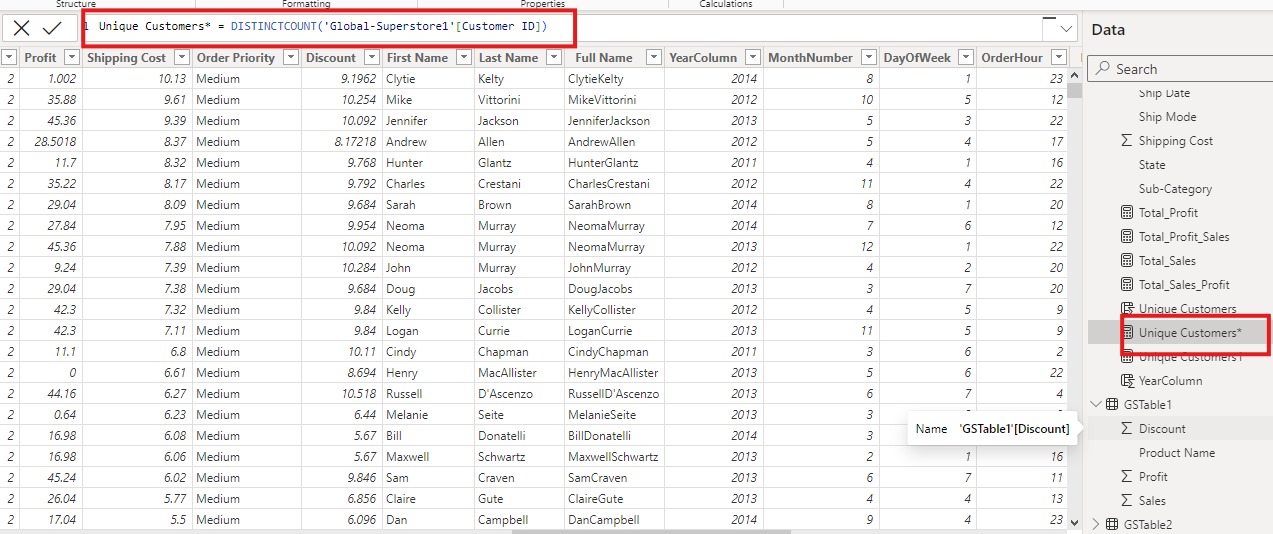
Counting Unique Values: A Guide to Power BI's DISTINCTCOUNT Function
Aug 03, 2024
Counting Unique Values: A
Guide to Power BI's DISTINCTCOUNT Function
In today's post, I'll explore one of Power BI's powerful
DAX functions, the DISTINCTCOUNT function. Whether you're analyzing customer
data, tracking inventory, or evaluating transactions, counting unique values is
a common and essential task. The DISTINCTCOUNT function simplifies this
process, allowing you to quickly and accurately determine the number of
distinct entries in a column. Join us as we delve into the syntax, use cases,
and practical examples of this versatile function, helping you unlock deeper
insights from your data.
Power BI is a powerful tool for data analysis and
visualization. One of its key features is the DAX (Data Analysis Expressions)
language, which includes a variety of functions for creating calculated columns
and measures. Among these, the DISTINCTCOUNT function is particularly useful
for counting unique values in a column. This blog will explore the
DISTINCTCOUNT function, its syntax, use cases, and examples.
What is the DISTINCTCOUNT
Function?
The DISTINCTCOUNT function in Power BI counts the number
of distinct (unique) values in a column. This function is particularly useful
for analyzing data where you need to know the number of unique entries, such as
counting the number of unique customers, products, or transactions.
Syntax
The syntax for the DISTINCTCOUNT function is
straightforward:

- column:
The column for which you want to count the distinct values.
Use Cases
Here are some common scenarios where the DISTINCTCOUNT
function can be applied:
- Counting Unique Customers:
In
a sales dataset, you might want to know how many unique customers made
purchases.
- Unique Product Count: In
inventory management, you might need to count the number of unique
products in stock.
- Distinct Transactions:
In
financial data, counting distinct transactions can help in identifying the
number of unique sales.
Examples
Let's explore some practical examples using the
DISTINCTCOUNT function.
Example 1: Counting Unique
Customers
Suppose you have a sales dataset with the following
columns: CustomerID, ProductID, SalesAmount. You want to count the number of
unique customers.
- Create a new measure:
Unique Customers = DISTINCTCOUNT(Sales[CustomerID])
- Add this measure to your report: Drag and drop the measure to your
report to see the count of unique customers.
Example 2: Counting Unique
Products
In the same dataset, you might want to know the number
of unique products sold.
- Create a new measure:
Unique Products = DISTINCTCOUNT(Sales[ProductID])
- Add this measure to your report: This will show the number of distinct
products sold.
Example 3: Distinct
Transactions by Month
You may want to count the number of unique transactions
for each month. Assuming you have a TransactionDate column:
- Create a calculated column to extract the month from the
transaction date:
Transaction Month = MONTH(Sales[TransactionDate])
- Create a measure to
count the unique transactions per month:
Unique Transactions per Month =
DISTINCTCOUNT(Sales[TransactionID])
- Visualize the measure:
Use
a bar chart to display the number of unique transactions for each month.
Combining DISTINCTCOUNT with
Other Functions
The DISTINCTCOUNT function can be combined with other
DAX functions for more complex calculations. For example, you might want to
count the number of unique customers who purchased a specific product:
Unique Customers for Product =
CALCULATE(DISTINCTCOUNT(Sales[CustomerID]), Sales[ProductID] =
"ProductA")
Illustrative Example of DISTINCTCOUNT
Function


Conclusion
The DISTINCTCOUNT function in Power BI is a versatile
tool for counting unique values in a dataset. By understanding its syntax and
use cases, you can leverage this function to gain valuable insights from your
data. Whether you're analyzing customer data, inventory, or transactions, the
DISTINCTCOUNT function can help you answer critical business questions.
For more detailed guidance and in-depth training, visit
our training
here.

